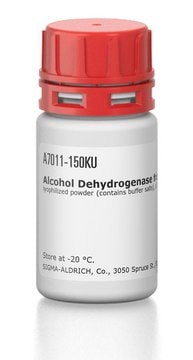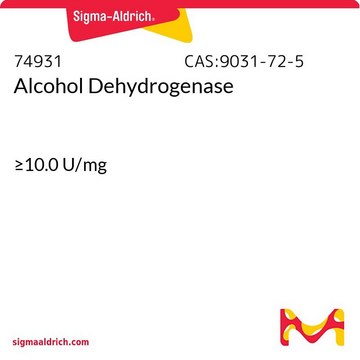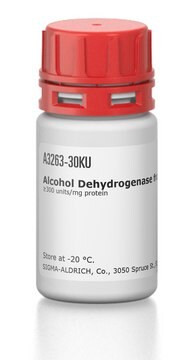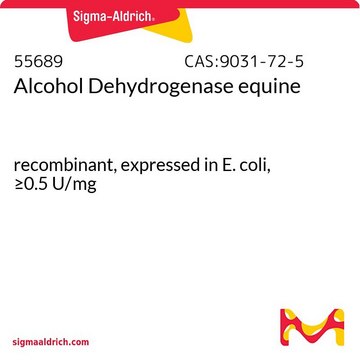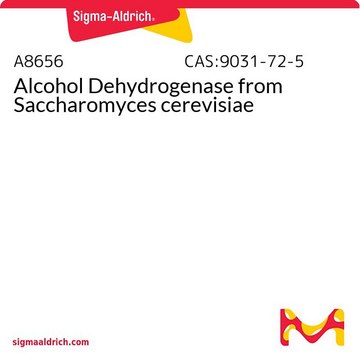49641
Alcohol Dehydrogenase, recombinant from E. coli
≥500 U/mL
Synonym(s):
Alcohol:NADP+ oxidoreductase
Sign Into View Organizational & Contract Pricing
All Photos(1)
About This Item
CAS Number:
MDL number:
UNSPSC Code:
12352204
NACRES:
NA.54
Recommended Products
recombinant
expressed in E. coli
Quality Level
form
liquid
specific activity
≥500 U/mL
technique(s)
cell based assay: suitable
color
light brownish-yellow to brown-green
suitability
suitable for molecular biology
application(s)
life science and biopharma
storage temp.
−20°C
Looking for similar products? Visit Product Comparison Guide
General description
Research area: Neuroscience
Alcohol dehydrogenase has a homodimeric structure with a co-enzyme binding domain at the C-terminal and an N-terminal catalytic domain. The active site is located at the interdomain cleft. Binding of NAD+ in the active site causes conformational changes that create the binding site for the alcohol substrate.
Alcohol dehydrogenase has a homodimeric structure with a co-enzyme binding domain at the C-terminal and an N-terminal catalytic domain. The active site is located at the interdomain cleft. Binding of NAD+ in the active site causes conformational changes that create the binding site for the alcohol substrate.
Application
Alcohol dehydrogenase (ADH) has been used for the reversal of deficient 3-[4,5-dimethylthiazol-2-yl]-2,5 diphenyl tetrazolium bromide (MTT) assay reduction in the disrupted schizophrenia 1 (DISC1-FL) and DB7 cell lysate.
Biochem/physiol Actions
Alcohol dehydrogenase catalyzes the oxidative conversion of alcohol into aldehyde. The metabolism of ethanol catalyzed by alcohol dehydrogenase (ADH) results in the generation of reactive oxygen species (ROS) and nitric oxide (NO) leading to oxidative damage to mitochondria and cellular proteins and is further associated with the onset of neuroinflammation and neurological disorders.
Unit Definition
1 U corresponds to the amount of enzyme which reduces 1 μmol acetone per minute at pH 7.0 and 30°C (NADPH as cofactor)
Signal Word
Warning
Hazard Statements
Precautionary Statements
Hazard Classifications
Eye Irrit. 2
Storage Class Code
10 - Combustible liquids
WGK
WGK 3
Flash Point(F)
Not applicable
Flash Point(C)
Not applicable
Personal Protective Equipment
dust mask type N95 (US), Eyeshields, Gloves
Choose from one of the most recent versions:
Already Own This Product?
Find documentation for the products that you have recently purchased in the Document Library.
Structure of a triclinic ternary complex of horse liver alcohol dehydrogenase at 2.9 A resolution.
H Eklund et al.
Journal of molecular biology, 146(4), 561-587 (1981-03-15)
F Colonna-Cesari et al.
The Journal of biological chemistry, 261(32), 15273-15280 (1986-11-15)
A study of the hinge bending mode in the enzyme liver alcohol dehydrogenase is made by use of empirical energy functions. The enzyme is a dimer, with each monomer composed of a coenzyme binding domain and a catalytic domain with
H Eklund et al.
Biochemistry, 23(25), 5982-5996 (1984-12-04)
The binding of NAD to liver alcohol dehydrogenase has been studied in four different ternary complexes by using crystallographic methods. These complexes crystallize isomorphously in a triclinic crystal form which contains the whole dimer of the enzyme in the asymmetric
Tomáš Pluskal et al.
Nature plants, 5(8), 867-878 (2019-07-25)
Kava (Piper methysticum) is an ethnomedicinal shrub native to the Polynesian islands with well-established anxiolytic and analgesic properties. Its main psychoactive principles, kavalactones, form a unique class of polyketides that interact with the human central nervous system through mechanisms distinct
Albert Rosell et al.
Journal of molecular biology, 330(1), 75-85 (2003-06-24)
The amphibian enzyme ADH8, previously named class IV-like, is the only known vertebrate alcohol dehydrogenase (ADH) with specificity towards NADP(H). The three-dimensional structures of ADH8 and of the binary complex ADH8-NADP(+) have been now determined and refined to resolutions of
Our team of scientists has experience in all areas of research including Life Science, Material Science, Chemical Synthesis, Chromatography, Analytical and many others.
Contact Technical Service